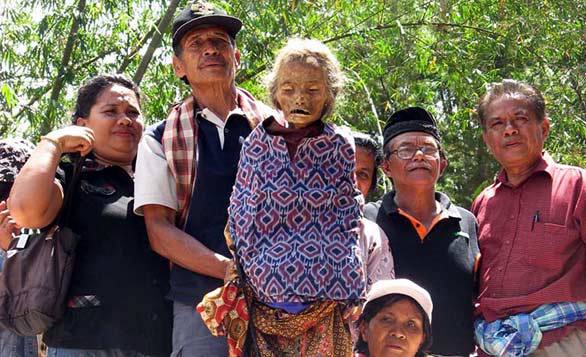11 Fascinating Funeral Traditions From Around the Globe
The funerals I’ve attended have all been very much the same. Relatives and friends arrive in all black and take seats in the church or synagogue pews for a somber ceremony where prayers are said, memories are shared and tears are shed. The attendees walk slowly out to their cars and form a single file line a behind the hearse, arriving at the graveyard where they place roses on the casket just before it’s lowered into the ground. Then, they proceed to the immediate family’s home, where the doorbell rings with a steady stream of loved ones — casserole dishes in hand — since, in the days ahead, people often forget to eat.
In today’s talk, cultural anthropologist Kelli Swazey shares with us a different approach to memorializing the dead. In Tana Toraja in eastern Indonesia, funerals are raucous affairs involving the whole village that can last anywhere from days to weeks. Families save up for long periods of time to raise the resources for a lavish funeral, where sacrificial water buffalo will carry the deceased’s soul to the afterlife. Until that moment — which can take place years after physical death — the dead relative is referred to simply as a “person who is sick,” or even one “who is asleep.” They are laid down special rooms in the family home, where they are symbolically fed, cared for and taken out — very much a part of their relative’s lives.
In this practice, Swazey sees something truly beautiful. Watch this fascinating talk for her lovely reflections on what these rituals express that the West may be missing.
Funeral practices are deeply ingrained in culture and, around the globe, hugely varied traditions reflect a wide spread of beliefs and values. Here, a look at just a few of funeral traditions that might strike someone outside a culture as odd.
The New Orleans jazz funeral. It’s one of the prototypical images of New Orleans, Louisiana: the boisterous, jazz-tinged funeral procession. Fusing West African, French and African-American traditions, funerals in New Orleans strike a unique balance between joy and grief as mourners are lead by a marching band. The band plays sorrowful dirges at first, but once the body is buried, they shift to an upbeat note. Cathartic dancing is generally a part of the event, to commemorate the life of the deceased. [Wikipedia]
South Korean burial beads. The Week reported last year on a growing trend in South Korea, where a law passed in 2000 requires anyone burying a loved one to remove the grave after 60 years. Because of dwindling graveyard space and this resulting law, cremation has become much more popular. But families don’t always opt for ashes. Several companies there compress remains into gem-like beads in turquoise, pink or black. These “death beads” are then displayed in the home. [The Week]
Filipino death traditions. Many ethnic groups in the Philippines have unique funeral practices. The Benguet of Northwestern Philippines blindfold their dead and place them next to the main entrance of the house, while their Tinguian neighbors dress the body in their best clothes, sit them on a chair and place a lit cigarette in their lips. The Caviteño, who live near Manila, bury their dead in a hollowed-out tree trunk. When someone becomes ill, they select the tree where they will eventually be entombed. Meanwhile, the Apayo, who live in the north, bury their dead under the kitchen. [Wikipedia]
Sky burial in Mongolia and Tibet. Many Vajrayana Buddhists in Mongolia and Tibet believe in the transmigration of spirits after death – that the soul moves on, while the body becomes an empty vessel. To return it to the earth, the body is chopped into pieces and placed on a mountaintop, which exposes it to the elements — including vultures. It’s a practice that’s been done for thousands of years but, according to a recent report, about 80% of Tibetans still choose it. [The Buddhist Channel]
Green funerals. In the United States, more and more people are opting for environmentally friendly burials. This means skipping embalming processes, nixing traditional concrete vaults and getting biodegradable, woven-willow caskets, which decompose into the ground. The Green Burial Council has approved 40 environmentally friendly cemeteries in the U.S. — way up from a decade ago. Another option: becoming a memorial “reef ball.” A company called Eternal Reefs compresses remains into a sphere that is attached to a reef in the ocean, providing a habitat for sea life. [Newsweek, Wall Street Journal]

An image from a Balinese cremation ceremony in 2010. Photo: Flickr/Graeme Churchard
Balinese cremation. “Strange as it seems, it is in their cremation ceremonies that the Balinese have their greatest fun,” Miguel Covarrubias wrote in the 1937 book, Island of Bali. In 2008, the island saw one of its most lavish cremations ever as Agung Suyasa, head of the royal family, was burned along with 68 commoners. Thousands of volunteers gathered to carry a giant bamboo platform, as well as an enormous wooden bull and wooden dragon. After a long procession, Suyasa’s body was eventually placed inside the bull and burned as the dragon stood witness. In the Balinese tradition, cremation releases the soul so it is free to inhabit a new body — and doing this is considered a sacred duty. [The New York Times]
The turning of the bones in Madagascar. The Malagasy people of Madagascar have a famous ritual called “famadihana” or “the turning of the bones.” Once every five or seven years, a family has a celebration at its ancestral crypt where the bodies, wrapped in cloth, are exhumed and sprayed with wine or perfume. As a band plays at the lively event, family members dance with the bodies. For some, it’s a chance to pass family news to the deceased and ask for their blessings — for others, it’s a time to remember and tell stories of the dead. [The New York Times]
Aboriginal mortuary rites in Australia. When a loved one dies in Aboriginal society in Australia’s Northern Territory, elaborate rituals begin. First, a smoking ceremony is held in the loved one’s living area to drive away their spirit. Next a feast is held, with mourners painted ochre as they partake in food and dance. The body is traditionally placed atop a platform and covered in leaves as it is left to decompose. It has been reported that in some traditions, fluids from the platform can help identify the deceased’s killer. [PubMed]
Ghana fantasy coffins. In Ghana, people aspire to be buried in coffins that represent their work or something they loved in life. These so-called “fantasy coffins” were recently popularized by Buzzfeed, which showed images of 29 outrageous ones, from a coffin shaped like a Mercedes-Benz for a businessman to an oversized fish for a fisherman to a really big Bible for someone who loved going to church. [Buzzfeed]
Also worth noting: it’s not always black that signifies death, as it does in the West — white, purple, grey, green and yellow also mark the passage of life. Check out this visualization from TED speaker David McCandless to see which color is used where: row 16 shows the color associated with death and row 59 reveals the varied colors associated with mourning.
Liz Jacobs contributed to this post.
Article originally published by: Ted.com




